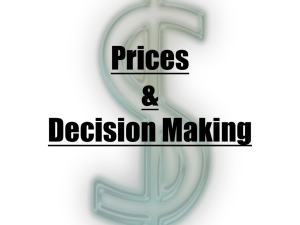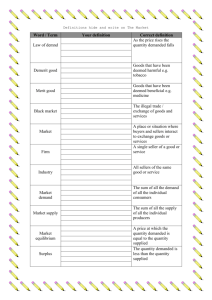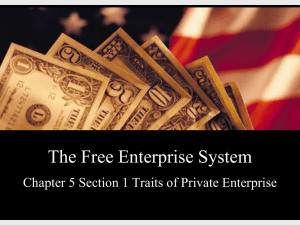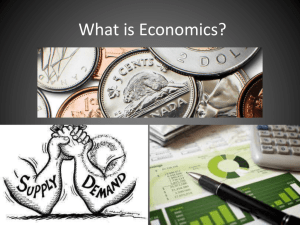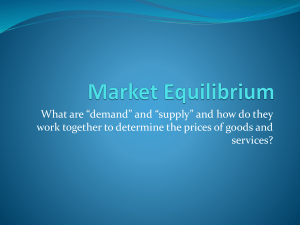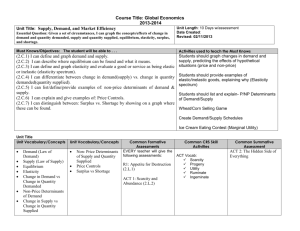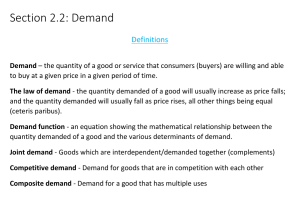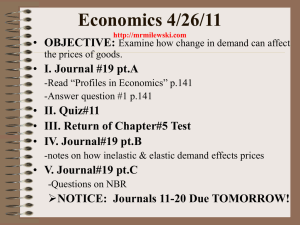PowerPoint
advertisement
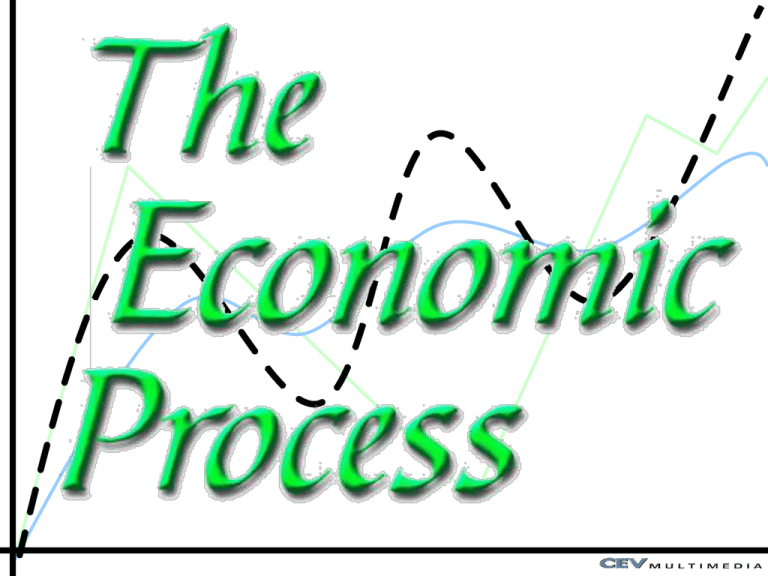
The Economic Process Objectives 1. To understand and define economic roles of wants and needs 2. To learn different economic resources and factors of production and distribution 3. To identify business cycles 4. To analyze the effects of supply and demand on economic decision making 2 What is Economics Scientific study of how governments, households or businesses deal with production, distribution and consumption of goods and services 3 Two Areas of Economic Study Macroeconomics Microeconomics Study of economies as a whole; the “Big Picture” Study of individual economic units, such as businesses and households 4 Goods and Services • Goods – tangible items purchased to fulfill a desire • Services – intangible tasks performed in exchange for something of value, such as money • Goods & services are used to fulfill a person’s wants or needs 5 Wants versus Needs 6 Economic Resources • Use natural, human and manufactured resources to create a good or service • Become factors of production when being transformed into a good or service 7 Factors of Production 8 Land • Is synonymous with natural resources • Consists of natural materials, such as: • Used in the production process • Includes items, such as: – – – – mineral deposits oil deposits forests water 9 Land resources can be classified into two categories 10 Labor • Is synonymous with human resources • Provides skills and talents to the production process through people • Changes land into goods & services 11 Capital 12 Management • Is synonymous with entrepreneur or enterpriser factor • Initiates production • Organizes the other three factors of production • Creates a profit when performed efficiently 13 Three questions related to production 14 Basic Economic Problem 15 How does society decide which wants are most important? 16 Opportunity Cost • The good or service you give up when you choose another good or service 17 Opportunity Cost 18 Three Important Roles Contribute to Economic Interdependence 19 Producers • Turn economic resources into factors of production • Produce goods & services to sell to distributors • Pay wages & benefits to consumers for labor used in production 20 Distributors • Buy goods & services from producers • Sell goods & services to consumers 21 Consumers • Buy goods & services from distributors • Work for producers to earn wages & benefits 22 Relationship 23 Cause and Effect Relationship Between Producers, Distributors and Consumers If one entity decides to cut back on spending, the other two are directly affected Example: 24 Business Cycle 25 Prosperity 26 Recession 27 Depression 28 Recovery 29 Economic Decisions Supply & demand affect the amount of goods and services produced and purchased 30 Demand At a given time, the quantity of goods & services buyers or consumers are willing to purchase at various prices Price $500 $450 $400 $350 $300 Quantity Demanded 50 100 150 200 250 31 Example 32 Supply At a given time the quantity of goods & services sellers are willing to offer at various prices Price $500 $450 $400 $350 $300 Quantity Supplied 250 200 150 100 50 33 Example 34 Supply and Demand 35 Supply and Demand Price Quantity Demanded Quantity Supplied Surplus (+) Shortage (-) $500 $450 $400 $350 $300 50 100 150 200 250 250 200 150 100 50 +200 +100 0 -100 -200 Price equilibrium 36 Supply and Demand 1. If the price is $500, quantity demanded is 50 and quantity supplied is 250; the surplus is 200 2. If the price is $450, quantity demanded is 100 and quantity supplied is 200; the surplus is100 37 3. 4. Supply and Demand If the price is $350, quantity demanded is 200 and quantity supplied is 100; there is a shortage of 100 If the price is $300, quantity demanded is 250 and quantity supplied is 50; there is a shortage of 200 38 Supply and Demand 39 Quiz 1. (T/F) Microeconomics is the study of the economy as a whole. 2. What is the difference between a want and a need? 3. List the four factors of production. 4. (T/F) Capital refers to the manufactured instruments used to further production. 5. Which of the following is not a question related to production? A. what B. how C. when D. who 40 Quiz 6. 7. 8. 9. State the basic economic problem. What is opportunity cost? List the four stages of the business cycle. Explain the difference between supply & demand. 10. (T/F) Equilibrium is the point where supply equals demand. 41
